
The Next Trillion Dollar Wave - AI Narrative in Crypto: Who Are the Top Players?
Dec 12, 2024 21:40
Written by TechFlow
From the primitive satisfaction of hunting and gathering to the instant gratification easily obtained through various digital media in modern society, human development seems to have always pursued a key neurotransmitter in the brain: dopamine.
Dopamine isn't just a simple "happiness molecule" - it's the core force driving human pursuit, learning, and adaptation. However, dopamine is both a reward and a challenge. In the crypto market, dopamine's influence is further amplified: whether in the speculation-filled crypto market or the recent rise of Telegram Mini Games, various addictive reward mechanisms cleverly exploit human craving for dopamine, creating unprecedented user stickiness and economic models.
Setting aside criticism of blind addiction mechanisms, as we delve into the current gaming trend within the Telegram×TON ecosystem, we must ask: Is this economic model built on instant gratification truly sustainable? While the "click-to-earn" gaming model constantly triggers the reward center in users' brains, dopamine comes and goes quickly. Can a gaming model supported by users' short-term pleasure evolve into a long-term stable economic ecosystem?
Following Notcoin's viral success, the "Tap to Earn" model has once again caught market attention. Catizen, viewed as a product in the same category, has garnered widespread market interest. On the surface, Catizen is another representative "Tap to Earn" game following Notcoin. However, viewing Catizen merely as another short-term project exploiting dopamine mechanisms might miss the opportunity to understand its true potential.
With the TGE (Token Generation Event) approaching, this article will deeply explore Catizen's development and planning. Through analyzing Catizen's operational data, strategic layout, and token planning, we'll examine how this phenomenal game can seamlessly transition from its impressive "first half" to a promising "second half" post-TGE.

Through carefully designed game mechanics and market anticipation, Catizen has taken the lead in the "Tap to Earn" wave. The challenge of user growth, which troubles many projects, naturally isn't an issue for Catizen, which understands the appeal of dopamine economics.
A Growth Miracle Driven by Dopamine
Openly embracing the massive traffic benefits of "Tap to Earn," Catizen has achieved impressive results: As of September 16th, Catizen has attracted over 3 million on-chain active users, 2.2 million Telegram premium users, recently reached 4.7 million weekly user growth, with total players exceeding 39 million, and achieved revenue of over $31 million.
The strong monetization model has attracted a significant number of high-quality paying users. High traffic + high retention + strong monetization - from just a Telegram Mini Game perspective, Catizen's current achievements are exceptional.
Outstanding operational results inevitably require an experienced and capable team. Catizen is published by Pluto Studio Limited, a technology-focused game studio with over 30 developers. Pluto Studio Limited also provides technical support for multiple Mini Games in the Catizen Miniapp Center.
The excellent Pluto Studio Limited has also gained support from various institutions, receiving investments from Binance Labs, HashKey Capital, Folius Ventures, and The Open Platform.
However, Catizen isn't just passively harvesting traffic or limiting itself to a simple "click-to-earn" model. Instead, it actively utilizes this hard-earned user attention, cleverly guiding it toward deeper ecosystem participation. Millions of active users aren't just chasing short-term click rewards but are gradually entering a carefully designed ecosystem network.
Setting the Stage for Ecosystem Development
From million-level user growth to strong monetization conversion, to gaining recognition from renowned investment institutions, Catizen's first half has undoubtedly been successful.
The team knows this is just the beginning. The real challenge isn't how to acquire traffic but how to convert this traffic into long-term value in the highly competitive Tap2Earn sector. From the start, Catizen's goal wasn't to compete fiercely in the mini-game sector but to "create incremental value." They view their first-half advantages as a springboard toward grander objectives, using traffic to build a comprehensive ecosystem and construct a truly sustainable business ecosystem with enormous value.
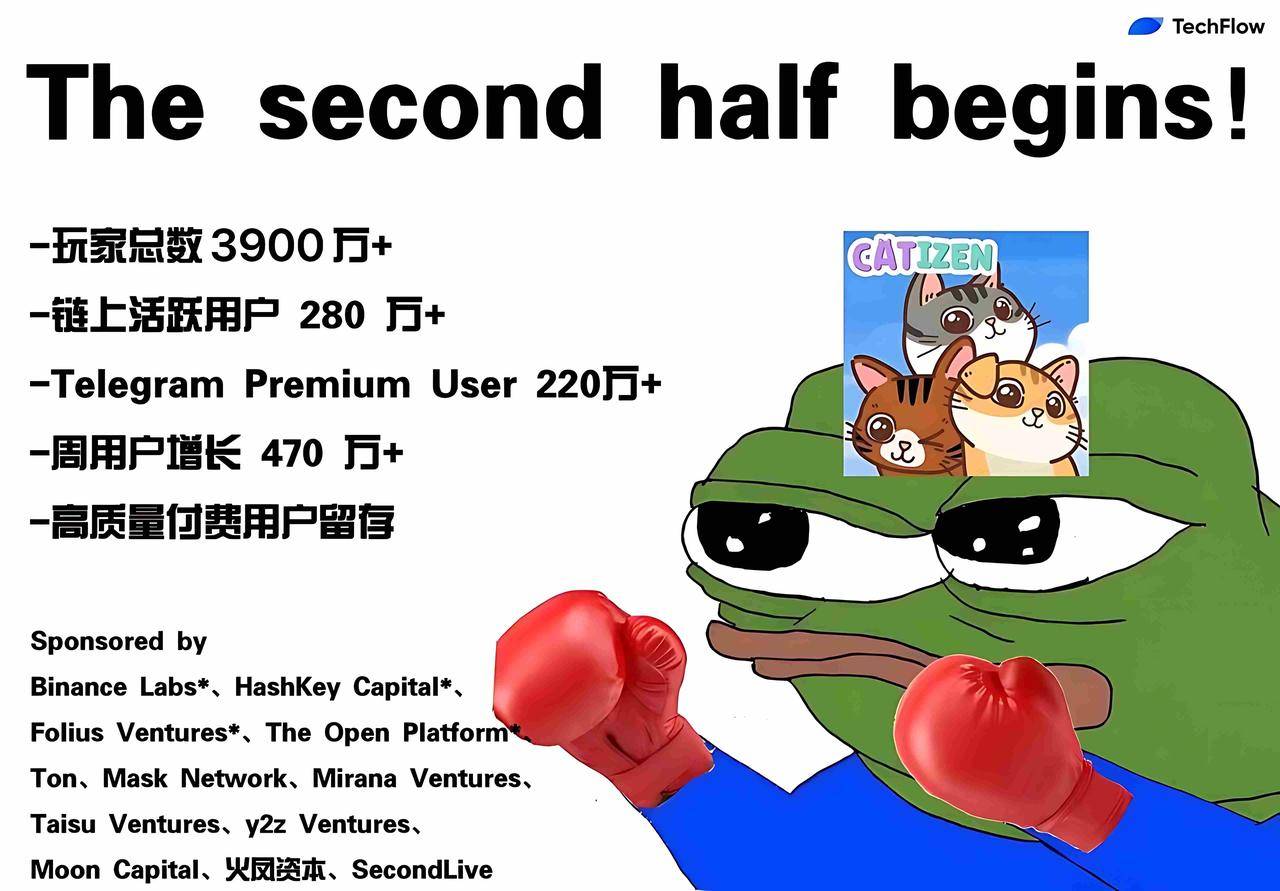
As a core component of Catizen's ecosystem development strategy, the Miniapp Center takes on the crucial role of bridging Catizen's first and second halves.
Miniapp Center
The Miniapp Center is Catizen's ecosystem application hub, offering various applications tailored to different user profiles. The Miniapp Center adopts an embedded approach, placing interface entry points within the Catizen application, seamlessly channeling Catizen's traffic.
Including Catizen itself, ten applications have already launched in the Miniapp Center. Besides the main game Catizen, other notable performers include Bombie, a Mini Game targeting GameFi & Meme enthusiasts, and Vanilla Trading Bot, a Telegram trading bot for crypto investors.
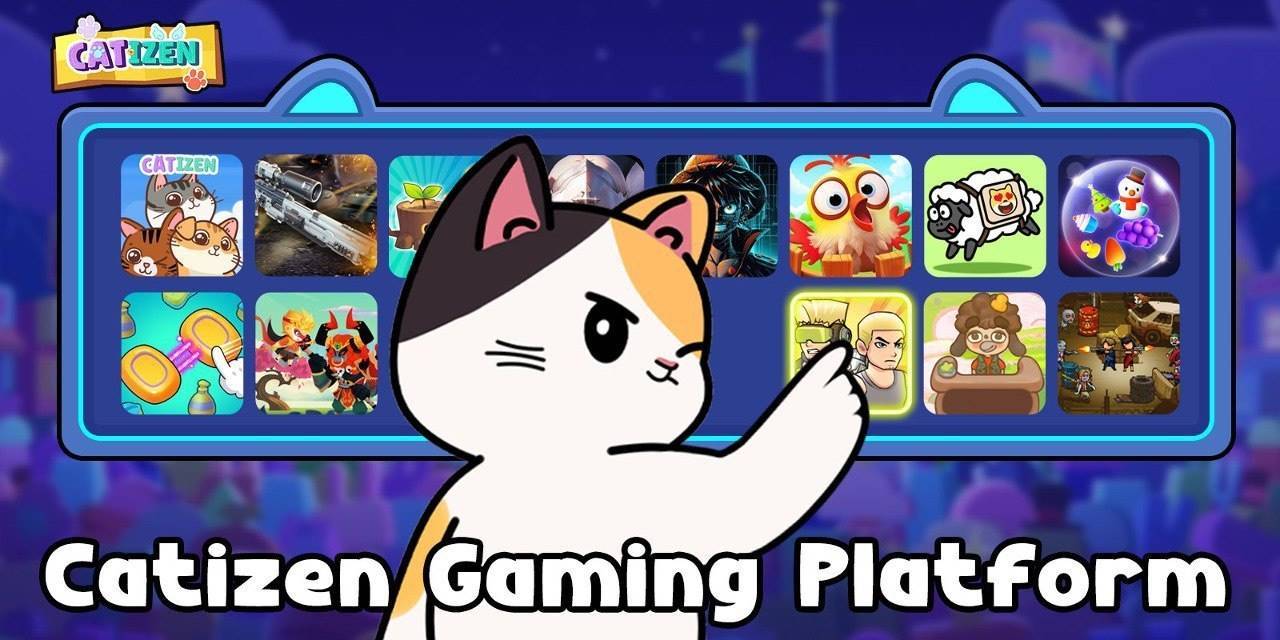
Bombie: A Playable Meme Game
Speaking of mini-games, we must mention WeChat Mini Programs, currently the world's most popular mini-game platform. In recent years, WeChat mini-game advertisements have flooded various social media applications, with their simple yet addictive gameplay and compelling monetization mechanisms making WeChat Mini Programs the most profitable gaming platform globally.
Bombie successfully replicated WeChat mini-games' "can't put it down" mechanics to Telegram while adding Web3 elements: introducing token airdrop mechanisms similar to Dogs, combining "infinite box-opening upgrade monster-fighting" gameplay with Memecoin airdrops. This allows players to both "actively spend money" on opening mystery boxes and have the motivation to "actively earn money" through random Memecoin drops in the game.
In less than three weeks, Bombie has achieved self-sustainability: total users have exceeded 1.7 million, daily active users surpass 700,000, daily paying users exceed 40,000, and total game revenue has surpassed $200,000 within two weeks.
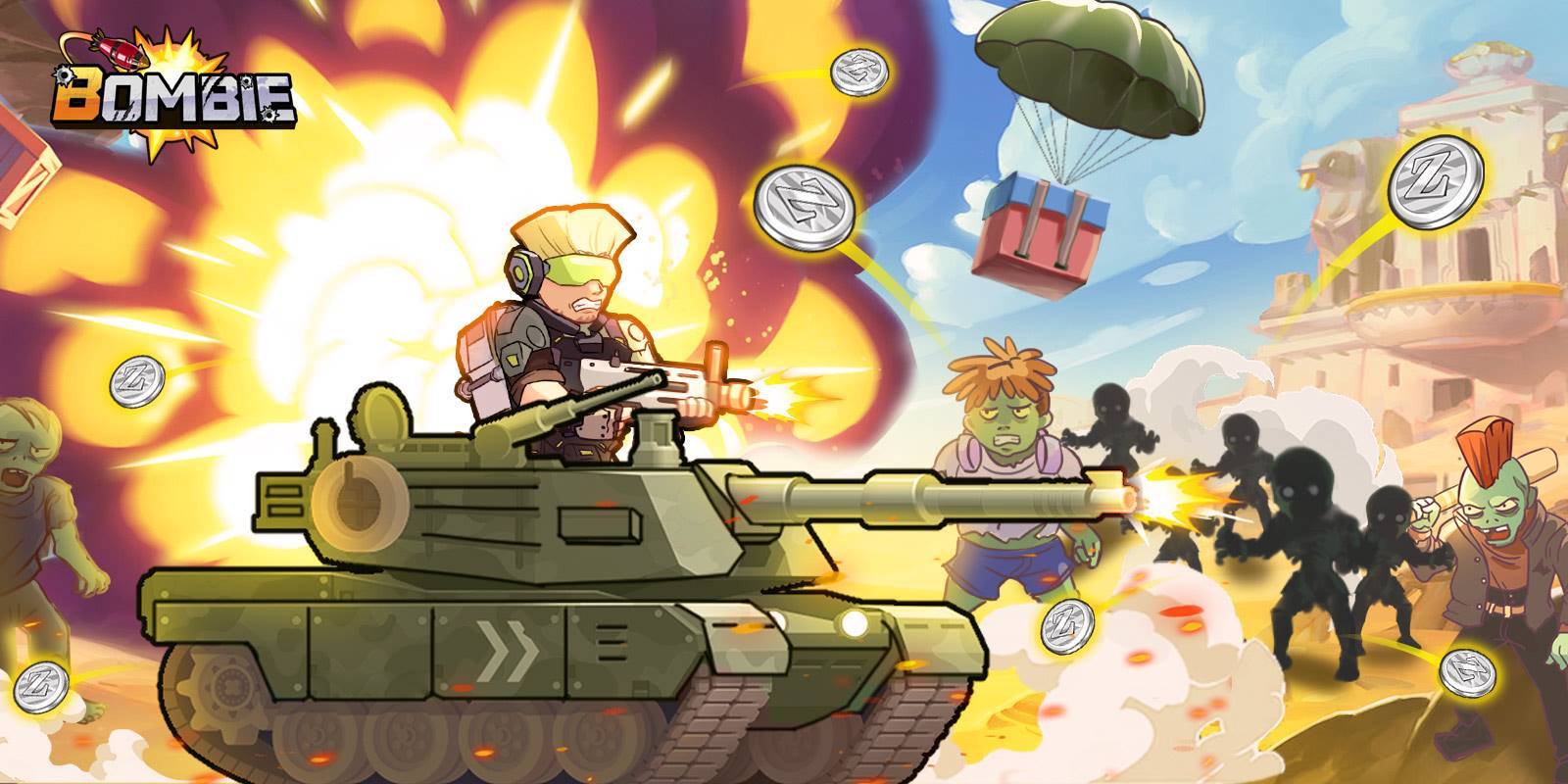
Vanilla Trading Bot: Making BTC Trading Accessible
Vanilla Trading Bot is an innovative trading tool allowing users to participate in BTC trading with minimal cost and risk. Users need less than $10 to operate trading volume equivalent to a complete Bitcoin.
Vanilla's operating principle is quite creative: Vanilla actually provides pre-purchased BTC in the background, while users can profit from price fluctuations on the Bot without actually buying or holding Bitcoin. While lowering entry barriers, it eliminates liquidation risk, as users don't need to worry about massive losses from extreme market conditions since they don't actually "hold" the traded assets.
Since its launch on September 4th, without promotional efforts, Vanilla Trading Bot has attracted 1.8 million registered users, 500,000 active traders, and achieves daily transaction volumes of millions of trades.
Catizen Task: Concrete Example of Traffic Integration
As mentioned earlier, the Miniapp Center adopts an in-game window entry mode. Similarly, Catizen's ecosystem traffic direction uses "embedded routing": directly channeling traffic from the Catizen game to other applications through Catizen tasks + airdrop rewards, while the Miniapp Center's pinning feature itself serves as a traffic director.
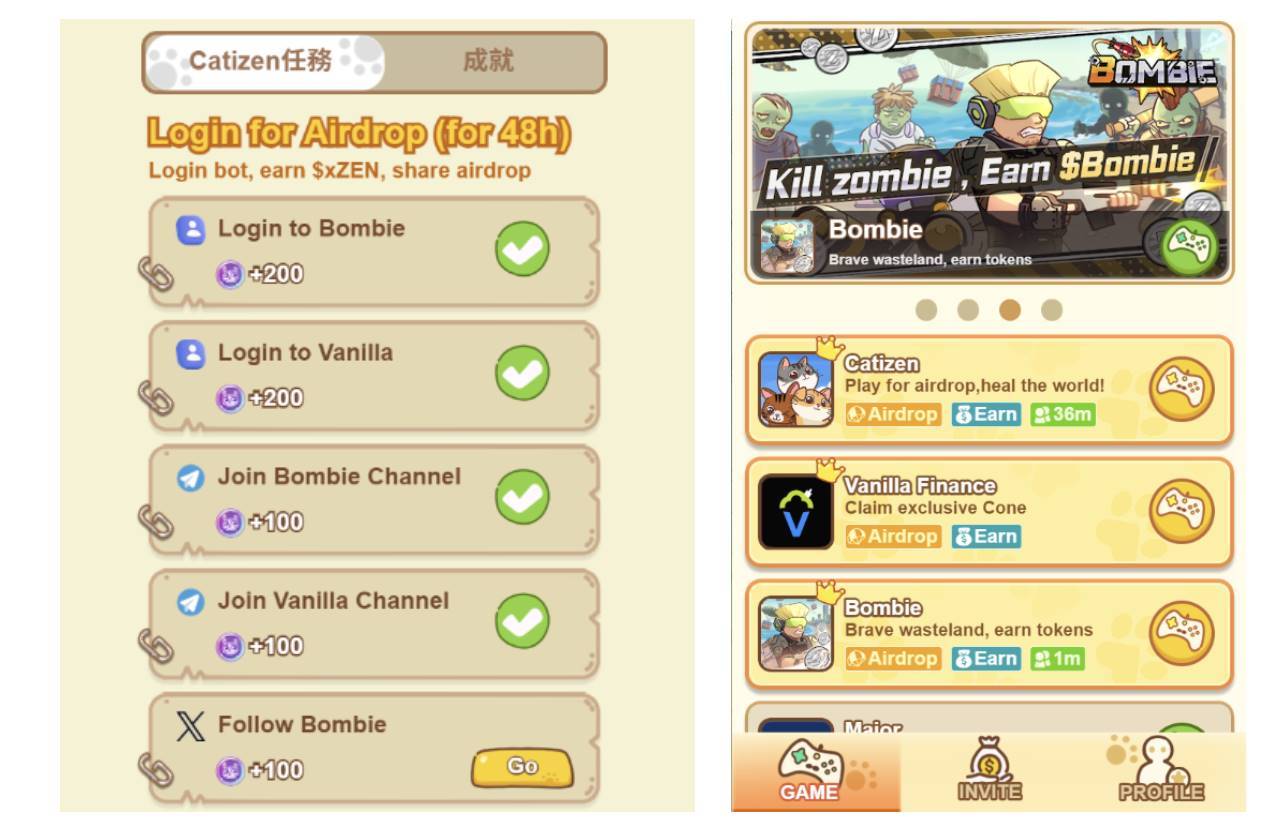
Behind Multiple Successes
The rapid launch and success of Bombie and Vanilla Trading Bot demonstrate the team's outstanding ability in rapid application development, migration deployment, and product optimization.
Behind this systematic success lies Catizen team's continuous testing of SDK and testing engines for over half a year before project launch. So although it quickly went viral and successfully monetized, the entire Catizen ecosystem isn't a hasty product - replicating similar achievements requires considerable time and experience accumulation.
Overall, the Miniapp Center positions itself as Catizen ecosystem's application incubator + traffic hub, helping new ecosystem applications quickly incubate and launch through application deployment + ecosystem joint traffic direction. The success of Bombie and Vanilla Trading Bot provides data-driven proof of Catizen Miniapp Center's effective and sustainable business model. This mature business model can continue to be applied in future ecosystem vertical sectors.
In Catizen's second-half planning, beyond the Miniapp Center breaking through model bottlenecks, Catizen's token $CATI consistently runs through the entire ecosystem, becoming the bond connecting users, games, and the overall ecosystem economy.
Although Catizen's early market attraction largely came from the upcoming token issuance expectation, in terms of overall ecosystem layout, Catizen's attitude toward the project token isn't one-and-done, but rather endowing the token with long-term multiple value capture capabilities.
TGE Approaching, Airdrop Allocation Details
Catizen will distribute $CATI airdrops to Silver level and above players, with all TGE portions belonging to the community, allocated as follows:
Airdrop and Ecosystem: 43%
Airdrop: 34%
15% 100% released at TGE for first season player rewards
19% 0% released at TGE, for future seasonal airdrop activities
Launchpool: 9%, 100% released at TGE
Total TGE phase release: 30.5% (of total supply)
Player airdrop: 15% (50% of TGE release)
Launchpool: 9%
Liquidity: 5%
Treasury: 1.5%
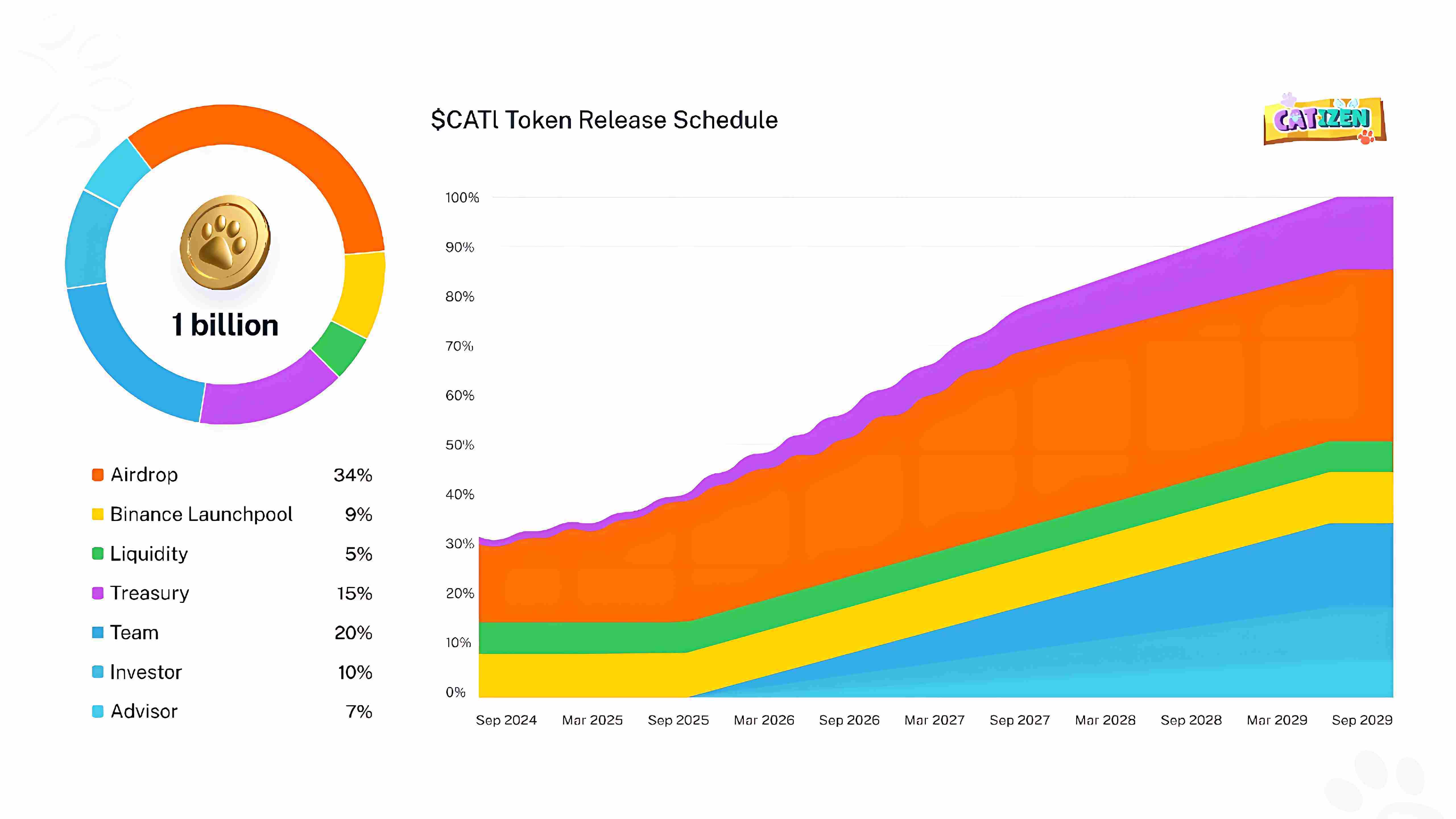
Diverse Use Cases, Real Benefits for Holders
Looking at Catizen's long-term planning, clearly a "one-time event" isn't $CATI's ultimate goal. Catizen has designed multiple use cases for $CATI:
Universal Currency Throughout the Ecosystem
$CATI will serve as the universal currency for Catizen ecosystem, MiniappCenter, Launchpool, and OpenTask. Users can seamlessly interact throughout the ecosystem using $CATI, from in-game purchases to participating in new project launches, creating constant demand for $CATI within the ecosystem.
In-Game Discounted Purchases
$CATI holders can purchase items and services at discounted prices in various Miniapp Center games, effectively saving costs whether spending on games or earning through them, combined with game mechanics that understand human nature.
Launchpool Staking Returns
In Catizen's ecosystem landscape, Launchpool is certainly crucial. As early as May, Catizen conducted a trial mining in-game, attracting over 170,000+ successful participants despite high entry requirements, showing excellent results.
Currently, the airdrop query page is live, allowing Catizen users to check airdrops in-game and stake $CATI on different exchanges to earn corresponding exchange token rewards, earning up to 600% APY additional returns. According to latest data, nearly 1 million $CATI Holders have participated in staking, with total staking exceeding 14.4 million $CATI, over 10% of TGE circulation.
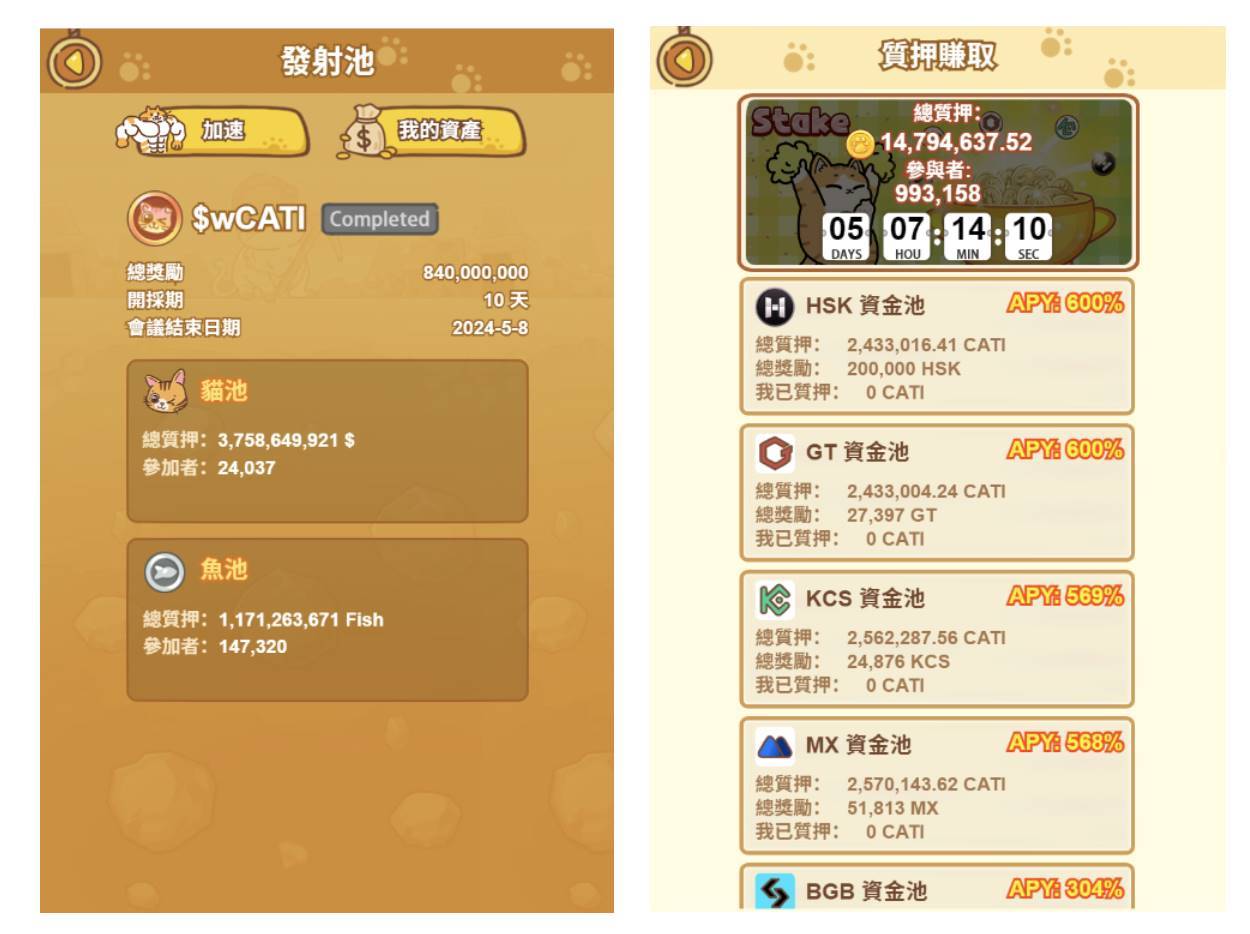
Long-term Benefits
As the ecosystem's main token, future Miniapp Center applications will share project returns with $CATI Holders in various forms. Given Catizen's development speed, earning passive income by holding $CATI is becoming increasingly accessible.
Ecosystem Governance Voting
In the future, hundreds of mini-games plan to launch on Miniapp Center, and to ensure diverse user experiences, Miniapp Center may also gradually launch currently popular Web2 games. At that time, Holders can vote on whether ecosystem applications should launch.
Through diverse long-term use cases, $CATI successfully integrates itself closely with various aspects of the Catizen ecosystem. The self-consistent design logic of "more holdings, more benefits" protects Holders while again confirming the ecosystem's future development approach: sustainable development isn't just talk.
Through its continuously growing positive cash flow, Catizen has not only validated its business model's feasibility and sustainability but also demonstrated its competitiveness within the TON ecosystem and the broader Crypto industry. In the current market environment filled with "Mass Adoption" narratives, Catizen's unique approach moves toward a more practical and sustainable business ecosystem.
Unlike many projects that solely emphasize attracting external users through "breaking out" strategies, Catizen's built business ecosystem appears more like a participation path genuinely considering Web3 users' interests.
This inside-out Mass Adoption might be the correct path to achieving breakthrough growth.
Recommendation
NAVI
NAVIs Rise in Sui Ecosystem: Building on Lending + LST Success, Ready to Scale as Native USDC Launch
Nov 11, 2024 15:34
CARV
New Rules of Data Value Distribution: How CARV is Powering Millions of Users?
Nov 11, 2024 15:49

From Graduate to CEO: Nexus Secures $25 Million Led by Pantera - Whats the Story?
Jun 06, 2024 19:01